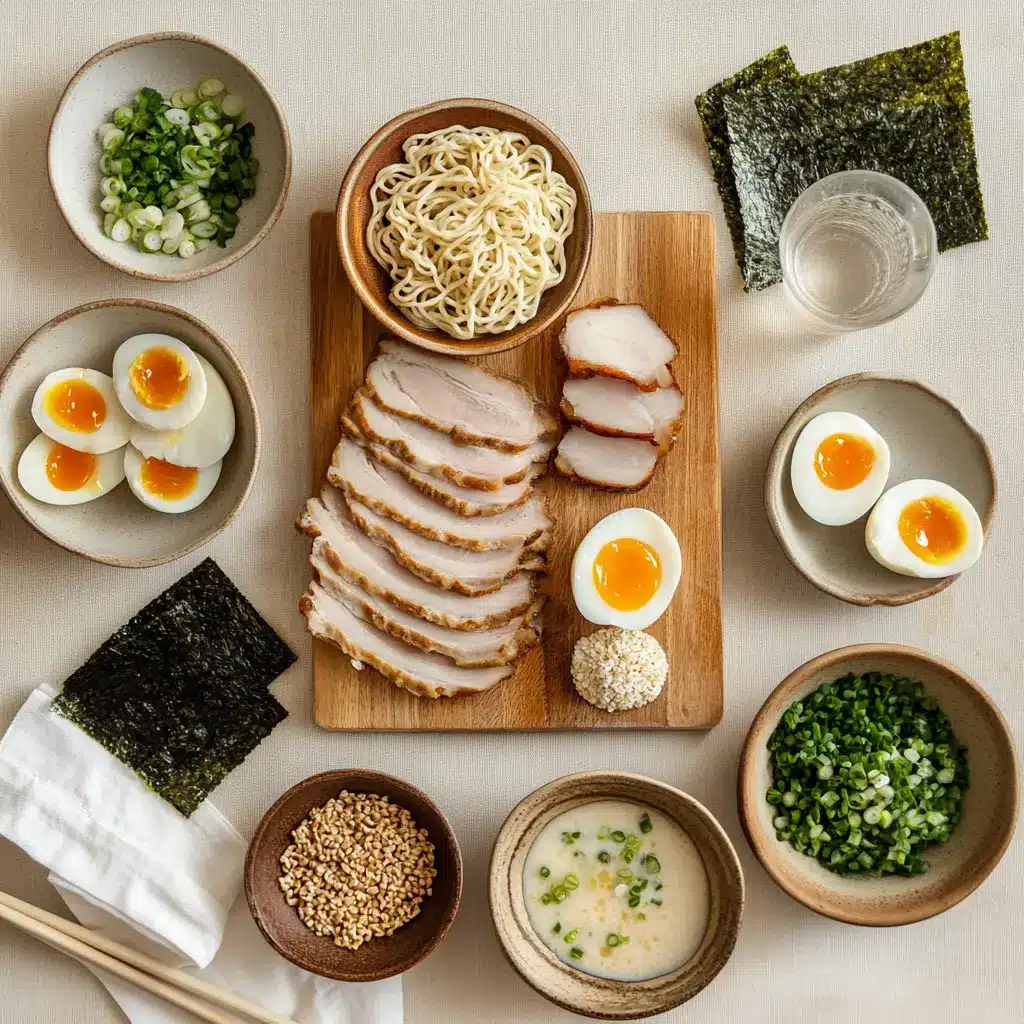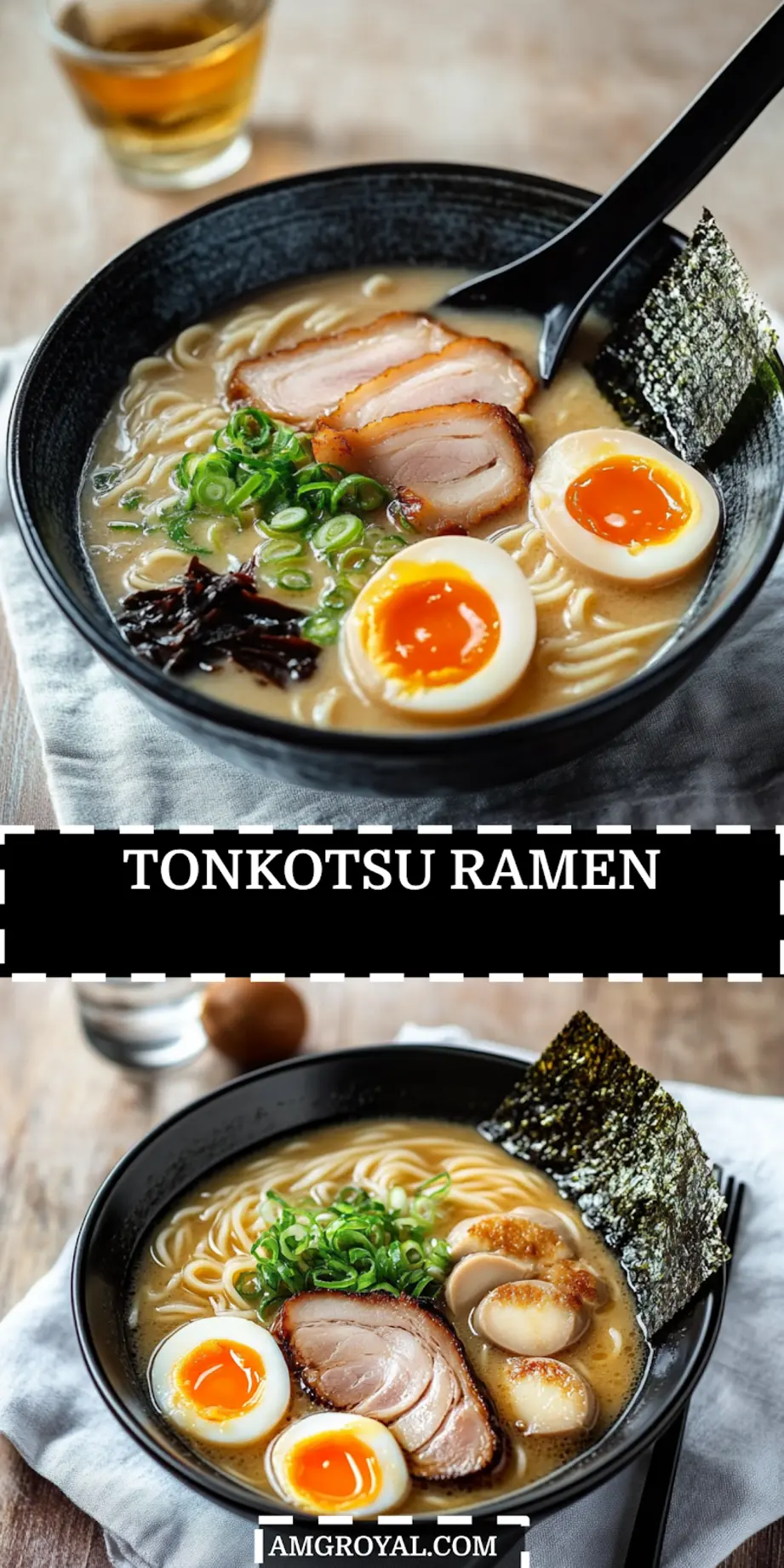You know that moment when you’re craving something soul-warming but also a little elevated? Tonkotsu ramen is having its well-earned spotlight, and it’s easy to see why. This rich, creamy pork bone broth with silky noodles feels like wrapping yourself in a cozy blanket. And here’s the best part this version simplifies the process without sacrificing flavor. No 12-hour marathon or hard-to-find specialty items required.
Think of this as your approachable gateway to ramen at home. We’re crafting tender pork, ultra-creamy broth that clings to springy noodles, and visually stunning toppings that deliver the Japanese ramen aesthetic and give your bowl major Instagram potential. It’s comfort food with a refined twist.
I’ve spent months testing the perfect blend of umami and just the right amount of spice in this recipe. It’s all about depth layering flavors to unlock that restaurant-quality taste. My twist? An unexpected tweak to the tare that brings balance and richness. You’ll know when you taste it.
Why This Tonkotsu Ramen Will Win Your Heart
There’s something transformative about a well-made bowl of tonkotsu ramen. The luscious ivory broth gets its richness and signature mouthfeel from slowly simmered pork bones that release their collagen and flavor over time. It’s soothing, savory, and surprisingly achievable in your own kitchen with the right technique.
I especially love how this homemade version builds complexity from simple, everyday ingredients. The resulting broth isn’t just flavorful it’s deeply comforting and coats every strand of noodle beautifully. Topped with jammy eggs, melt-in-your-mouth chashu pork, and vibrant garnishes, each bowl becomes your own little culinary masterpiece featuring the best of Japanese ramen presentation.
The Secret Behind That Creamy, Rich Broth
We build this broth in two critical phases: First, we blanch the pork bones to remove off-flavors and impurities. This ensures a smooth, clean-tasting base. Then they’re simmered for hours alongside aromatics. Patience here is key it allows the collagen from trotters and marrow bones to emulsify into that signature opaque, creamy broth.

Pro Tip: Don’t skip the pureed pork skin step it may sound unconventional, but it’s your ticket to that restaurant-level richness. This old-school hack helps give the broth that velvety texture and deep flavor ramen lovers crave.
| Phase | Time | What’s Happening |
|---|---|---|
| Blanching | 10 minutes | Clears impurities for clean broth |
| First Simmer | 4 hours | Extracting flavor and collagen |
| Final Simmer | 2 hours | Pureed pork skin thickens and enriches |
Essential Ingredients That Make the Difference
When it comes to ramen, the power is in the details. Start with fresh, quality ingredients especially your noodles. After investing hours into building a rich broth, you want noodles that can hold their own. Pork trotters are vital for that creamy texture, and dried shiitake mushrooms provide that extra umami punch.
Don’t overlook your aromatics: sautéing garlic, onions, ginger, and leeks deepens the flavor and develops the base aroma of your broth. Your kitchen will instantly smell like a cozy ramen shop.
| Ingredient | Purpose | Can’t Skip Because… |
|---|---|---|
| Pork Trotters | Natural collagen base | Creates that signature creamy body |
| Dried Shiitake | Boosts umami | Gives balance and earthy depth |
| High-Quality Noodles | Noodle integrity | Stays firm in rich broth |
| Fresh Aromatics | Flavor layering | Builds a flavorful, fragrant base |
Step-by-Step: Your Path to Ramen Perfection
Begin by blanching the bones to skim off any scum and impurities. After rinsing, build your broth: sauté aromatics in a large pot until aromatic, then return bones and water, and simmer for hours. Don’t rush this deep flavors take time.
Once the base broth is strained, puree the cooked pork skin separately and fold it into the broth. This step makes a world of difference, transforming thin stock into luscious, milky tonkotsu gold. The final two hours let the broth deepen and become full-bodied.
Note: Throughout, keep a close watch on the water level. The bones should stay fully submerged. Add hot water as needed, but avoid watering down your broth.
Making Your Bowl Picture-Perfect
Assembly is where the artistry comes in. Begin with chewy, freshly cooked noodles, then pour in that hot, silken broth. The way it envelops every noodle pure magic.
Garnish intentionally: place halved soft-boiled eggs so the yolk faces up; fan out slices of chashu pork; add scallions, nori strips, and optional black garlic oil or corn. Each component builds taste and texture, and together, it’s a bowl worthy of your best ramen photography.
Smart Swaps and Tweaks
If you can’t track down trotters, don’t panic. Butcher shops usually carry them upon request. As a substitute, combine extra pork bones (neck or back) with a packet of unflavored gelatin it helps mimic that velvety mouthfeel.
Menma is an iconic topping, but its funky kick isn’t for everyone. Try bean sprouts or sweet corn instead for gentle crunch. The goal is to strike that texture balance and build in variety.
| Original | Swap Option | Flavor Impact |
|---|---|---|
| Menma | Bean sprouts or corn | Fresh crunch vs. tang |
| Dried Shiitake | Fresh mushrooms | Milder, less concentrated flavor |
| Negi (green onion) | Regular scallions | Nearly identical, more available |
| Nori Sheets | Sesame seeds or omit | Less oceanic, adds nuttiness |
Storage and Reheating Like a Pro
Good news: your effort won’t go to waste. Tonkotsu broth actually improves after resting overnight. In the fridge, it transforms into a jiggly, collagen-rich gel. That’s a feature, not a flaw!
Store broth, noodles, and toppings separately. When ready to serve, gently reheat the broth (do not boil) and cook noodles fresh for each serving to maintain the perfect texture and bite. Leftover chashu can be quickly reheated by searing or served at room temp like traditional ramen shops.
| Component | Storage Method | Keeps For | Reheating Tip |
|---|---|---|---|
| Broth | Store in airtight container in fridge | Up to 3 days | Reheat gently over low heat, stir occasionally |
| Chashu Pork | Marinate in sealed container | Up to 4 days | Warm to room temp or lightly sear before serving |
| Boiled Eggs | Refrigerate in shell or marinade | 3 days | Serve at room temp for best texture |
Expert Insight: The Essence of Tonkotsu Ramen
At its core, tonkotsu ramen celebrates time, texture, and tradition. Simmering pork bones into a creamy emulsion transforms simple ingredients into a soul-satisfying broth. It’s this dedication to depth both of flavor and feeling that sets it apart. Every slurp carries the richness of hours in the pot and centuries of culinary evolution.
For more delicious recipes and cooking inspiration, follow me on Facebook, Pinterest and Reddit!
Mastering the Richness of Tonkotsu Ramen
Crafting this tonkotsu ramen broth has been a rewarding journey full of trial, error, and ultimately satisfaction. After many rounds of tweaking and seasoning, I found that silky equilibrium between savory and creamy. It’s now a favorite request in my home warm bowls packed with depth that spark joy and conversation around the table. That’s the essence of food, isn’t it?
FAQs ( Tonkotsu Ramen )

Your New Go-To Tonkotsu Ramen Adventure
This tonkotsu ramen recipe brings that authentic creamy richness home with only a day’s investment mostly passive. The slow simmer turns basic ingredients into a soul-warming broth that coats every noodle. The result? A deeply flavorful meal that tastes handcrafted and looks stunning.
Customize to your heart’s content: swirl in miso paste to amplify umami, or drizzle with chili oil for a bold spicy ramen aesthetic. For texture, try roasted corn or soft-boiled quail eggs. The broth freezes beautifully for up to three months portion it into mason jars for instant ramen nights. And here’s a smart noodle tip: save a splash of pasta water to help the broth cling better, per a chef buddy’s advice.
I’d love to see how you style your bowl. Share your creations and ramen photography tag me! Whether you’re revisiting nostalgic childhood flavors or diving into ramen for the first time, this dish brings people together around a steaming bowl of care and creativity.
PrintTONKOTSU RAMEN
Tonkotsu ramen is a rich and collagen-packed Japanese noodle dish featuring a creamy pork broth that simmers for hours. Perfect for ramen photography enthusiasts, this recipe delivers the authentic korean ramen aesthetic and spicy ramen aesthetic with every bowl.
- Prep Time: 20 minutes
- Cook Time: 6 hours
- Total Time: 6 hours 20 minutes
- Yield: 5–6 servings 1x
- Category: Main Course
- Method: Boiling and Simmering
- Cuisine: Japanese
Ingredients
- 5 to 6 servings Good quality ramen noodles (you don’t want to ruin that 6 hour broth with a crappy noodle)
- Chashu pork (recipe here)
- 5 to 6 pcs Boiled eggs
- Negi (spring onions) chopped
- Menma (fermented bamboo shoots) optional
- Roasted Nori squares
- 1 1/2 kg pork trotter
- 1 kg pork bones
- 1 large onion roughly chopped
- 1 whole garlic minced
- thumb sized ginger sliced thinly
- 2 pcs leeks roughly chopped
- 6 pcs dried shiitake mushrooms
- oil
- salt
Instructions
- In a large stock pot add pork trotters and pork bones then fill it with water enough to cover everything. Bring it to a boil and continue to boil until the scum appears on top. Turn the heat off then drain.
- Clean the pork bones and trotters in running water removing any scum that is stuck on it.
- In clean stock pot add oil then sauté onion, garlic and ginger.
- Add the pork trotters, bones, leeks, dried shiitake mushrooms and salt. Fill it again with water enough to cover everything roughly 4 to 5 litres, cover with heavy a lid then bring it to a boil. Once boiling reduce to simmering heat and simmer for 4 hours, check water levels making sure it does not dry out adding water if necessary.
- After 4 hours, turn the heat off then strain the liquid using a fine sieve into a separate pot, reserve the bones. At this point you need to have at least 3 litres of stock if not add water. Place pot on stove top then bring it to a boil, once boiling lower to simmering heat.
- Scrape off the very tender fat and skin from the trotter bones until you have around 1 1/2 cups of tender pork skin. Place them in a bowl then using a hand blender puree them until smooth in consistency, pour this into the simmering soup.
- Continue to simmer the broth for 2 more hours, season with salt then turn heat off.
- Cook ramen noodles according to packet instructions.
- Place ramen noodles in a bowl then pour the pork broth, top with thinly sliced Chashu pork, Boiled eggs, chopped spring onions, nori and menma.
Nutrition
- Serving Size: 1 bowl
- Calories: 600 kcal
- Sugar: 3g
- Sodium: 1200mg
- Fat: 40g
- Saturated Fat: 15g
- Unsaturated Fat: 20g
- Trans Fat: 0g
- Carbohydrates: 45g
- Fiber: 5g
- Protein: 35g
- Cholesterol: 100mg










